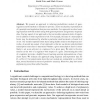Free Online Productivity Tools
i2Speak
i2Symbol
i2OCR
iTex2Img
iWeb2Print
iWeb2Shot
i2Type
iPdf2Split
iPdf2Merge
i2Bopomofo
i2Arabic
i2Style
i2Image
i2PDF
iLatex2Rtf
Sci2ools
RECOMB
2004
Springer
2004
Springer
Learning Regulatory Network Models that Represent Regulator States and Roles
Abstract. We present an approach to inferring probabilistic models of generegulatory networks that is intended to provide a more mechanistic representation of transcriptional regulation than previous methods. Our approach involves learning Bayesian network models using both gene-expression and genomic-sequence data. One key aspect of our approach is that our models represent states of regulators in addition to their expression levels. For example, the state of a transcription factor may be determined by whether a particular small molecule is bound to it or not. Our models represent these states using hidden nodes in the Bayesian networks. A second key aspect of our approach is that we use known and predicted transcription start sites to determine whether a given transcription factor is more likely to act as an activator or a repressor for a given gene. We refer to this distinction as the role of a regulator with respect to a gene. Determining the roles of a regulator provides a helpful...
Computational Biology | Key Aspect | Particular Small Molecule | RECOMB 2004 | Transcription Factor |
| Added | 03 Dec 2009 |
| Updated | 03 Dec 2009 |
| Type | Conference |
| Year | 2004 |
| Where | RECOMB |
| Authors | Keith Noto, Mark Craven |
Comments (0)

